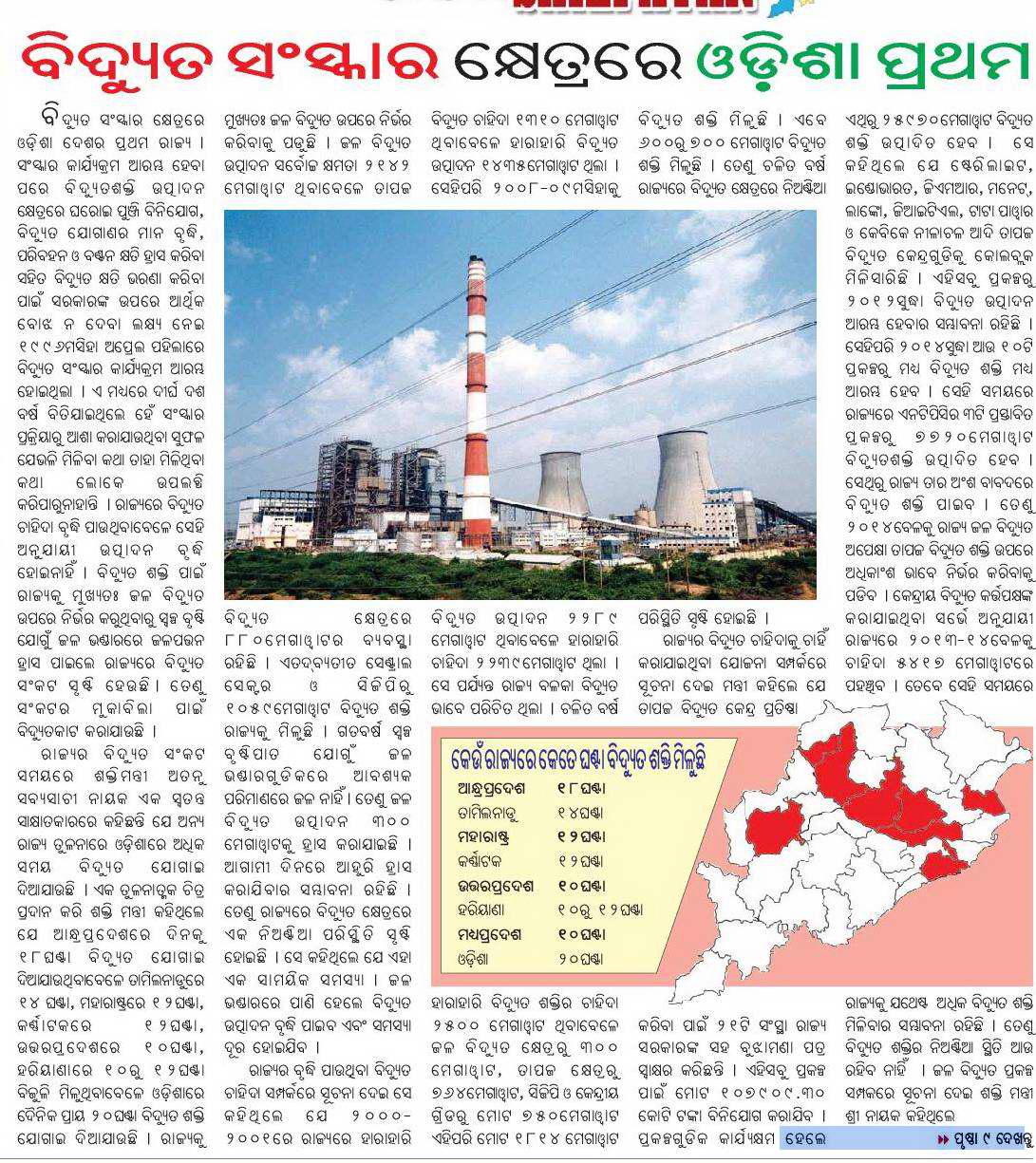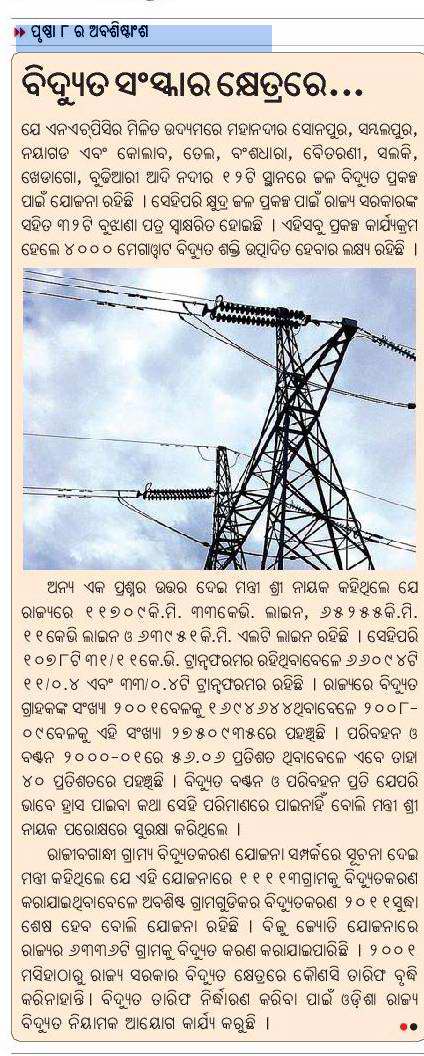For the last several months various media reports have made the following points regarding the power situation in Odisha:
Bimal Pandia has some of the facts behind all these in his blog. Following is an excerpt from his blog.
OERC has noted that the Grid Corporation (Gridco) – which buys power from producers and sells to distribution companies – has suffered huge losses and by the end of year 2009-10 the loss may well surpass 1,500 crore rupees. While the loss to Gridco is true, not many people know that the loss was – to a large extent – an outcome of very low power supply from Orissa Hydro Power Corporation (OHPC), the state owned corporation that owns hydro-power units in Orissa.
The Gridco procures power from various sources at OERC fixed rates. As per the process, Gridco had informed the OERC that Orissa will require a total of 18,726.15 Million Unit (MU) in the year 2009-10. It then informed about the sources from which it intends to procure and meet this requirement. Like the Gridco, other players in the power supply network like the power producers, transmitters and consumer representatives also submitted their design power generation, expenditure burdens and what price they expect etc. Taking everything into account the OERC decides quantity of power to be supplied to Gridco and their rate. It also decides power tariff for consumers and end users. While going through this process for the year 2009-10, the Gridco had submitted its plan to meet Orissa’s power requirement. There is no point for guessing that hydro power being the cheapest among all sources was and is the first choice for Gridco. The Gridco, relying on OHPC sources, had estimated that it will get 6,184.44 MU from OHPC. However parties appearing for the consumers submitted that this was a too conservative estimate and ‘Gridco has merely accepted the data submitted by the OHPC and has not done independent assessment of hydro power availability’. They submitted that ‘the availability of power from state hydro stations would be around 7,680 MU in FY 2009-10 as against the GRIDCO proposal of 6,184 MU’. But the OERC negated consumer’s estimation and instead agreed to the estimates made by Gridco. Though, OERC did not agree to consumer’s assertion that the consumers are losing out on cheapest energy, still 6184 MU from the OHPC in the year 2009-10 was the single most dominant procurement source for Gridco. This allotment constituted about one-third of its total energy procurement target for the year at a very cheap rate of 57.66 paise per unit on an average with power from Machhkund being the cheapest among all hydro power centres at 13.90 paise per unit and Indravati being the costliest at 73.35 paise.
In contrast, other sources – from which Gridco budgeted to procure the remaining two-third of required power – were 3.35 to 5.2 times costlier. The purchase rate – fixed by OERC – from Orissa Power Generation Corporation (OPGC) owned thermal power plants is 193.70 paise per unit; from Central Power Generation Corporation (Primarily NTPC) is 197.31 paise; from central hydro sources like Chukha, Tala and Teesta is 190.30 paise; from Captive Generation Plants (CGPs) in Orissa is 300 paise; and from renewable sources at 269.43 paise per unit. OHPC’s power, being the cheapest and the largest source, was expected to moderate all these costly sources and keep Gridco’s total purchase cost at 2,923.80 crore rupees for 19,619.11 MU of power required for Orissa in the year 2009-10, at 148.27 paise per unit.
So the power sources, per unit cost, units to be made available etc. were all decided by the OERC. Had everything gone as per the plan, Gridco would not have bled losses. But that was not to be. OHPC – the most vital source that moderated Gridco’s total purchasing cost to a reasonable level – faltered in making committed supply to the Gridco. For a period OHPC’s supply almost dried up as if its reservoir beds have gone bare. At the last count, OHPC managed to produce just 4,136.139 MU till 25 March, 2010. With only six days remaining of this financial year, the OHPC is expected to produce another 60 MU. This will take OHPC’s total energy production for the year 2009-10 to about 4,200 MU. This is a mere two-third of what was expected from it. Because of this huge deficit supply from the OHPC, the Gridco was forced to scout for other suppliers to plug the gap. That has undone all calculations and caused severe losses to Gridco. As the other sources from which Gridco gets supply are already stretched, they are in no position to make additional supply to Gridco. Even if they make supply, the cost will be many times more than that of OHPC’s power. Now, Gridco has no other way than to purchase power from wily producers at exorbitant cost. Some privately owned CGPs, with whom the Gridco has purchase agreement, charge OERC fixed rate up to the agreement level. Beyond that… it’s the producer’s fiefdom – to grab profits as much as possible from the Gridco’s misery. The negotiations are held hardly on equal terms. The OERC plays no role there; it does not have any jurisdiction to play either. Naturally, power rates spiral with the summer heat. In such a similar situation, the Gridco purchased power at more than 800 paise per unit last year. The situation is ripe to worsen this year. Gridco has lost substantial units of very low cost energy – hydro power – and is now compensating that loss with very high cost energy.
The above explains the situation very nicely. Mr. Pandia then gives the data on the reservoir situation and says that they are in better shape (based on March 1 data) than previous years. But then he speculates that some "cleaver ploy is cooking." I think his analysis in the excerpt above explains the situation nicely. In short the initial OERC tariff was based on some assumption on how much power will come from OHPC. Now that OHPC did not supply that amount of power the last year (leading to 1000+ crore loss to OERC) and may not supply that amount this year, obviously OERC has to revise its tariff based on the new reality of how much power will come from where and how much will it cost.
Moreover, all these have not much to do with whether Odisha is a power surplus state or not. There is now a power market in the country. It is a question of balancing the cost of power and the revenue from the consumers.




